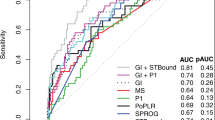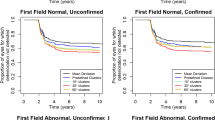Abstract
Glaucoma is a common disease of the eye that often results in partial blindness. The main symptom of glaucoma is the progressive deterioration of the visual field. Glaucoma management involves monitoring the progress of the disease using regular visual field tests but currently there is no standard method for classifying changes in visual field measurements. Sequence matching techniques typically rely on similarity measures. However, visual field measurements are very noisy, particularly in people with glaucoma. It is therefore difficult to establish a reference data set including both stable and progressive visual fields. We describe method that uses a baseline computed from a query sequence, to match stable sequences in a database collected from volunteers. The results suggest that the new method is more accurate than other techniques for identifying progressive sequences, though there is a small penalty for stable sequences.
Preview
Unable to display preview. Download preview PDF.
Similar content being viewed by others
References
Mitchell, P., Smith, W., Attebo, K., Healey, P.R.: Prevalence of Open-Angle Glaucoma in Australia. The Blue Mountains Eye Study. Ophthalmology 103, 1661–1669 (1996)
Rochtchina, E., Mitchell, P.: Projected Number of Australians with Glaucoma in 2000 and 2030. Clin Experiment Ophthalmol 28, 146–148 (2000)
Johnson, C.A., Sample, P.A., Zangwill, L.M., et al.: Structure and Function Evaluation (SAFE): 2. Comparison of Optic Disk and Visual Field Characteristics. American Journal of Ophthalmology 135, 148–154 (2003)
Flammer, J., Drance, S.M., Zulauf, M.: Differential Light Threshold. Arch. Ophthalmol. 102, 704–706 (1984)
Heijl, A., Lindgren, G., Olsson, J., Asman, P.: Visual Field Interpretation with Empiric Probability Maps. Arch. Ophthalmol. 107, 204–208 (1989)
Katz, J., Congdon, N., Friedman, D.S.: Methodological Variations in Estimating Apparent Progressive Visual Field Loss in Clinical Trials of Glaucoma Treatment. Arch. Ophthalmol. 117, 1137–1142 (1999)
Lazarescu, M., Turpin, A.: Classifying Glaucomatous Progression using Decision Trees. In: Proceedings of IASTED International Symposia on Applied Informatics. Innsbruck, Austria, pp. 205–210 (2003)
Lin, A., Hoffman, D., Gaasterland, D.E., Caprioli, J.: Neural Networks to Identify Glaucomatous Visual Field Progression. American Journal of Ophthalmology 135, 49–54 (2003)
Morgan, R.K., Feuer, W.J., Anderson, D.R.: Statpac 2 Glaucoma Change Probability. Arch. Ophthalmol. 109, 1690–1692 (1991)
Turpin, A., Frank, E., Hall, M., Witten, I.H., Johnson, C.A.: Detecting Progression in Glaucoma using Data Mining Techniques. In: Proceedings of the 5th Pacific Asia Conference on Knowledge Discovery and Data Mining, pp. 136–147 (2001)
Spry, P.G., Johnson, C.A., Chauhan, B.C.: Identification of Progressive Glaucomatous Visual Field Loss. Survey of Ophthalmology 47, 158–173 (2002)
Lane, T., Brodley, C.E.: Sequence Matching and Learning in Anomaly Detection for Computer Security. In: Fawcett, H., Provost, S. (eds.) AI Approaches to Fraud Detection and Risk Management, pp. 43–49. AAAI Press, Menlo Park (1997)
Navarro, G.: A Guided Tour to Approximate String Matching. ACM Computing Surveys 33, 31–38 (2001)
Anderson, D.R., Patella, V.M.: Automated Static Perimetry, 2nd edn., Mosby (1999)
Spry, P.G., Bates, A.B., Johnson, C.A., Chauhan, B.C.: Simulation of Longitudinal Threshold Visual Field Data. Investigative Ophthalmology and Visual Science 41, 2192–2200 (2000)
Vesti, E., Spry, P.G., Chauhan, B.C., Johnson, C.A.: Sensitivity Differences between Real Patient and Computer Stimulated Visual Fields. Journal of Glaucoma 11, 35–45 (2002)
Heijl, A., Lindgren, A., Lindgren, G.: Test-Retest Variability in Glaucomatous Visual Fields. American Journal of Ophthalmology 108, 130–135 (1989)
Hughes, A., Grawoig, D.: Statistics: A Foundation for Analysis. Addison-Wesley, Reading (1971)
Henson, D.B., Chaudry, S., Artes, P.H., Faragher, E.B., Ansons, A.: Response Variability in the Visual Field: Comparison of Optic Neuritis, Glaucoma, Ocular Hypertension, and Normal Eyes. Investigative Ophthalmology and Visual Science 41, 417–421 (2000)
Sheskin, D.J.: Handbook of Parametric and Nonparametric Statistical Procedures, 2nd edn. Chapman & Hall/CRC (2000)
Vesti, E., Johnson, C.A., Chauhan, B.C.: Comparison of Different Methods for Detecting Glaucomatous Visual Field Progression. Investigative Ophthalmology and Visual Science 44, 3873–3879 (2003)
Author information
Authors and Affiliations
Editor information
Editors and Affiliations
Rights and permissions
Copyright information
© 2006 Springer-Verlag Berlin Heidelberg
About this paper
Cite this paper
Meng, S., Lazarescu, M., Ivins, J., Turpin, A. (2006). Monitoring Glaucomatous Progression: Classification of Visual Field Measurements Using Stable Reference Data. In: Yeung, D.S., Liu, ZQ., Wang, XZ., Yan, H. (eds) Advances in Machine Learning and Cybernetics. Lecture Notes in Computer Science(), vol 3930. Springer, Berlin, Heidelberg. https://doi.org/10.1007/11739685_78
Download citation
DOI: https://doi.org/10.1007/11739685_78
Publisher Name: Springer, Berlin, Heidelberg
Print ISBN: 978-3-540-33584-9
Online ISBN: 978-3-540-33585-6
eBook Packages: Computer ScienceComputer Science (R0)




